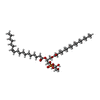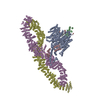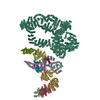[English] 日本語
 Yorodumi
Yorodumi- PDB-7sx3: Human NALCN-FAM155A-UNC79-UNC80 channelosome with CaM bound, conf... -
+ Open data
Open data
- Basic information
Basic information
| Entry | Database: PDB / ID: 7sx3 | ||||||
|---|---|---|---|---|---|---|---|
| Title | Human NALCN-FAM155A-UNC79-UNC80 channelosome with CaM bound, conformation 1/2 | ||||||
 Components Components |
| ||||||
 Keywords Keywords | MEMBRANE PROTEIN / ion channel / calmodulin / HEAT repeat protein | ||||||
| Function / homology |  Function and homology information Function and homology informationmonoatomic cation homeostasis / positive regulation of synaptic transmission, cholinergic / leak channel activity / regulation of resting membrane potential / cation channel complex / CaM pathway / Cam-PDE 1 activation / Sodium/Calcium exchangers / Calmodulin induced events / voltage-gated sodium channel activity ...monoatomic cation homeostasis / positive regulation of synaptic transmission, cholinergic / leak channel activity / regulation of resting membrane potential / cation channel complex / CaM pathway / Cam-PDE 1 activation / Sodium/Calcium exchangers / Calmodulin induced events / voltage-gated sodium channel activity / Reduction of cytosolic Ca++ levels / Activation of Ca-permeable Kainate Receptor / CREB1 phosphorylation through the activation of CaMKII/CaMKK/CaMKIV cascasde / Loss of phosphorylation of MECP2 at T308 / CREB1 phosphorylation through the activation of Adenylate Cyclase / CaMK IV-mediated phosphorylation of CREB / PKA activation / negative regulation of high voltage-gated calcium channel activity / Glycogen breakdown (glycogenolysis) / CLEC7A (Dectin-1) induces NFAT activation / Activation of RAC1 downstream of NMDARs / negative regulation of ryanodine-sensitive calcium-release channel activity / organelle localization by membrane tethering / mitochondrion-endoplasmic reticulum membrane tethering / autophagosome membrane docking / negative regulation of calcium ion export across plasma membrane / regulation of cardiac muscle cell action potential / presynaptic endocytosis / Synthesis of IP3 and IP4 in the cytosol / sodium channel activity / regulation of cell communication by electrical coupling involved in cardiac conduction / Phase 0 - rapid depolarisation / calcineurin-mediated signaling / Negative regulation of NMDA receptor-mediated neuronal transmission / Unblocking of NMDA receptors, glutamate binding and activation / RHO GTPases activate PAKs / calcium ion import across plasma membrane / Uptake and function of anthrax toxins / Ion transport by P-type ATPases / regulation of ryanodine-sensitive calcium-release channel activity / Long-term potentiation / protein phosphatase activator activity / Calcineurin activates NFAT / Regulation of MECP2 expression and activity / DARPP-32 events / monoatomic ion channel complex / Smooth Muscle Contraction / detection of calcium ion / regulation of cardiac muscle contraction / catalytic complex / RHO GTPases activate IQGAPs / regulation of cardiac muscle contraction by regulation of the release of sequestered calcium ion / monoatomic cation channel activity / cellular response to interferon-beta / calcium channel inhibitor activity / Activation of AMPK downstream of NMDARs / Protein methylation / presynaptic cytosol / regulation of release of sequestered calcium ion into cytosol by sarcoplasmic reticulum / Ion homeostasis / eNOS activation / titin binding / Tetrahydrobiopterin (BH4) synthesis, recycling, salvage and regulation / sperm midpiece / regulation of calcium-mediated signaling / voltage-gated potassium channel complex / potassium ion transmembrane transport / calcium channel complex / FCERI mediated Ca+2 mobilization / substantia nigra development / sodium ion transmembrane transport / regulation of heart rate / Ras activation upon Ca2+ influx through NMDA receptor / FCGR3A-mediated IL10 synthesis / Antigen activates B Cell Receptor (BCR) leading to generation of second messengers / calyx of Held / bioluminescence / adenylate cyclase activator activity / sarcomere / VEGFR2 mediated cell proliferation / protein serine/threonine kinase activator activity / regulation of cytokinesis / VEGFR2 mediated vascular permeability / positive regulation of synaptic transmission, GABAergic / generation of precursor metabolites and energy / spindle microtubule / positive regulation of receptor signaling pathway via JAK-STAT / Translocation of SLC2A4 (GLUT4) to the plasma membrane / calcium channel regulator activity / RAF activation / Transcriptional activation of mitochondrial biogenesis / response to calcium ion / calcium ion transmembrane transport / cellular response to type II interferon / Stimuli-sensing channels / G2/M transition of mitotic cell cycle / long-term synaptic potentiation / spindle pole / RAS processing / Signaling by RAF1 mutants Similarity search - Function | ||||||
| Biological species |  Homo sapiens (human) Homo sapiens (human) | ||||||
| Method | ELECTRON MICROSCOPY / single particle reconstruction / cryo EM / Resolution: 3.1 Å | ||||||
 Authors Authors | Kschonsak, M. / Chua, H.C. / Weidling, C. / Chakouri, N. / Noland, C.L. / Schott, K. / Chang, T. / Tam, C. / Patel, N. / Arthur, C.P. ...Kschonsak, M. / Chua, H.C. / Weidling, C. / Chakouri, N. / Noland, C.L. / Schott, K. / Chang, T. / Tam, C. / Patel, N. / Arthur, C.P. / Leitner, A. / Ben-Johny, M. / Ciferri, C. / Pless, S.A. / Payandeh, J. | ||||||
| Funding support | 1items
| ||||||
 Citation Citation |  Journal: Nature / Year: 2022 Journal: Nature / Year: 2022Title: Structural architecture of the human NALCN channelosome. Authors: Marc Kschonsak / Han Chow Chua / Claudia Weidling / Nourdine Chakouri / Cameron L Noland / Katharina Schott / Timothy Chang / Christine Tam / Nidhi Patel / Christopher P Arthur / Alexander ...Authors: Marc Kschonsak / Han Chow Chua / Claudia Weidling / Nourdine Chakouri / Cameron L Noland / Katharina Schott / Timothy Chang / Christine Tam / Nidhi Patel / Christopher P Arthur / Alexander Leitner / Manu Ben-Johny / Claudio Ciferri / Stephan Alexander Pless / Jian Payandeh /    Abstract: Depolarizing sodium (Na) leak currents carried by the NALCN channel regulate the resting membrane potential of many neurons to modulate respiration, circadian rhythm, locomotion and pain sensitivity. ...Depolarizing sodium (Na) leak currents carried by the NALCN channel regulate the resting membrane potential of many neurons to modulate respiration, circadian rhythm, locomotion and pain sensitivity. NALCN requires FAM155A, UNC79 and UNC80 to function, but the role of these auxiliary subunits is not understood. NALCN, UNC79 and UNC80 are essential in rodents, and mutations in human NALCN and UNC80 cause severe developmental and neurological disease. Here we determined the structure of the NALCN channelosome, an approximately 1-MDa complex, as fundamental aspects about the composition, assembly and gating of this channelosome remain obscure. UNC79 and UNC80 are massive HEAT-repeat proteins that form an intertwined anti-parallel superhelical assembly, which docks intracellularly onto the NALCN-FAM155A pore-forming subcomplex. Calmodulin copurifies bound to the carboxy-terminal domain of NALCN, identifying this region as a putative modulatory hub. Single-channel analyses uncovered a low open probability for the wild-type complex, highlighting the tightly closed S6 gate in the structure, and providing a basis to interpret the altered gating properties of disease-causing variants. Key constraints between the UNC79-UNC80 subcomplex and the NALCN DI-DII and DII-DIII linkers were identified, leading to a model of channelosome gating. Our results provide a structural blueprint to understand the physiology of the NALCN channelosome and a template for drug discovery to modulate the resting membrane potential. | ||||||
| History |
|
- Structure visualization
Structure visualization
| Movie |
 Movie viewer Movie viewer |
|---|---|
| Structure viewer | Molecule:  Molmil Molmil Jmol/JSmol Jmol/JSmol |
- Downloads & links
Downloads & links
- Download
Download
| PDBx/mmCIF format |  7sx3.cif.gz 7sx3.cif.gz | 916 KB | Display |  PDBx/mmCIF format PDBx/mmCIF format |
|---|---|---|---|---|
| PDB format |  pdb7sx3.ent.gz pdb7sx3.ent.gz | 696.8 KB | Display |  PDB format PDB format |
| PDBx/mmJSON format |  7sx3.json.gz 7sx3.json.gz | Tree view |  PDBx/mmJSON format PDBx/mmJSON format | |
| Others |  Other downloads Other downloads |
-Validation report
| Summary document |  7sx3_validation.pdf.gz 7sx3_validation.pdf.gz | 1.8 MB | Display |  wwPDB validaton report wwPDB validaton report |
|---|---|---|---|---|
| Full document |  7sx3_full_validation.pdf.gz 7sx3_full_validation.pdf.gz | 1.8 MB | Display | |
| Data in XML |  7sx3_validation.xml.gz 7sx3_validation.xml.gz | 121.7 KB | Display | |
| Data in CIF |  7sx3_validation.cif.gz 7sx3_validation.cif.gz | 184.5 KB | Display | |
| Arichive directory |  https://data.pdbj.org/pub/pdb/validation_reports/sx/7sx3 https://data.pdbj.org/pub/pdb/validation_reports/sx/7sx3 ftp://data.pdbj.org/pub/pdb/validation_reports/sx/7sx3 ftp://data.pdbj.org/pub/pdb/validation_reports/sx/7sx3 | HTTPS FTP |
-Related structure data
| Related structure data |  25492MC  7sx4C M: map data used to model this data C: citing same article ( |
|---|---|
| Similar structure data |
- Links
Links
- Assembly
Assembly
| Deposited unit | 
|
|---|---|
| 1 |
|
- Components
Components
-Protein , 5 types, 5 molecules ABCDE
| #1: Protein | Mass: 234128.797 Da / Num. of mol.: 1 Source method: isolated from a genetically manipulated source Source: (gene. exp.)  Homo sapiens (human) / Gene: NALCN, VGCNL1, eGFP / Cell line (production host): Expi293 / Production host: Homo sapiens (human) / Gene: NALCN, VGCNL1, eGFP / Cell line (production host): Expi293 / Production host:  Homo sapiens (human) / References: UniProt: Q8IZF0, UniProt: A0A7G8ZY66 Homo sapiens (human) / References: UniProt: Q8IZF0, UniProt: A0A7G8ZY66 |
|---|---|
| #2: Protein | Mass: 54205.004 Da / Num. of mol.: 1 Source method: isolated from a genetically manipulated source Source: (gene. exp.)  Homo sapiens (human) / Gene: FAM155A / Cell line (production host): Expi293 / Production host: Homo sapiens (human) / Gene: FAM155A / Cell line (production host): Expi293 / Production host:  Homo sapiens (human) / References: UniProt: B1AL88 Homo sapiens (human) / References: UniProt: B1AL88 |
| #3: Protein | Mass: 16852.545 Da / Num. of mol.: 1 Source method: isolated from a genetically manipulated source Source: (gene. exp.)  Homo sapiens (human) / Gene: CALM1, CALM, CAM, CAM1 / Cell line (production host): Expi293 / Production host: Homo sapiens (human) / Gene: CALM1, CALM, CAM, CAM1 / Cell line (production host): Expi293 / Production host:  Homo sapiens (human) / References: UniProt: P0DP23 Homo sapiens (human) / References: UniProt: P0DP23 |
| #4: Protein | Mass: 285174.938 Da / Num. of mol.: 1 Source method: isolated from a genetically manipulated source Source: (gene. exp.)  Homo sapiens (human) / Gene: UNC79, UNC79, KIAA1409 / Cell line (production host): Expi293 / Production host: Homo sapiens (human) / Gene: UNC79, UNC79, KIAA1409 / Cell line (production host): Expi293 / Production host:  Homo sapiens (human) / References: UniProt: Q9P2D8 Homo sapiens (human) / References: UniProt: Q9P2D8 |
| #5: Protein | Mass: 366510.594 Da / Num. of mol.: 1 Source method: isolated from a genetically manipulated source Source: (gene. exp.)  Homo sapiens (human) / Gene: UNC80, C2orf21, KIAA1843 / Cell line (production host): Expi293 / Production host: Homo sapiens (human) / Gene: UNC80, C2orf21, KIAA1843 / Cell line (production host): Expi293 / Production host:  Homo sapiens (human) / References: UniProt: Q8N2C7 Homo sapiens (human) / References: UniProt: Q8N2C7 |
-Sugars , 1 types, 2 molecules 
| #6: Sugar |
|---|
-Non-polymers , 3 types, 9 molecules 




| #7: Chemical | ChemComp-PEV / ( #8: Chemical | #9: Chemical | |
|---|
-Details
| Has ligand of interest | N |
|---|---|
| Has protein modification | Y |
-Experimental details
-Experiment
| Experiment | Method: ELECTRON MICROSCOPY |
|---|---|
| EM experiment | Aggregation state: PARTICLE / 3D reconstruction method: single particle reconstruction |
- Sample preparation
Sample preparation
| Component | Name: Pentameric complex of the leak channel NALCN with FAM155A, Calmodulin, UNC79 and UNC80 Type: COMPLEX Details: Calmodulin was not overexpressed but co-purified from Expi293 cells Entity ID: #1-#5 / Source: RECOMBINANT | |||||||||||||||
|---|---|---|---|---|---|---|---|---|---|---|---|---|---|---|---|---|
| Molecular weight | Experimental value: NO | |||||||||||||||
| Source (natural) | Organism:  Homo sapiens (human) Homo sapiens (human) | |||||||||||||||
| Source (recombinant) | Organism:  Homo sapiens (human) / Strain: Expi293 Homo sapiens (human) / Strain: Expi293 | |||||||||||||||
| Buffer solution | pH: 7.5 | |||||||||||||||
| Buffer component |
| |||||||||||||||
| Specimen | Conc.: 1.65 mg/ml / Embedding applied: NO / Shadowing applied: NO / Staining applied: NO / Vitrification applied: YES Details: NALCN was reconstituted into lipid nanodiscs and mildly crosslinkned with 0.05% EM grade glutaraldehyde for 10 min at room temperature. Cross-linking was quenched with 9 mM Tris pH 7.5 | |||||||||||||||
| Specimen support | Grid material: GOLD / Grid mesh size: 300 divisions/in. / Grid type: UltrAuFoil R0.6/1 | |||||||||||||||
| Vitrification | Instrument: LEICA EM GP / Cryogen name: ETHANE / Humidity: 100 % / Chamber temperature: 277 K / Details: 3.5 sec blotting |
- Electron microscopy imaging
Electron microscopy imaging
| Experimental equipment |  Model: Titan Krios / Image courtesy: FEI Company |
|---|---|
| Microscopy | Model: FEI TITAN KRIOS |
| Electron gun | Electron source:  FIELD EMISSION GUN / Accelerating voltage: 300 kV / Illumination mode: FLOOD BEAM FIELD EMISSION GUN / Accelerating voltage: 300 kV / Illumination mode: FLOOD BEAM |
| Electron lens | Mode: BRIGHT FIELD / Nominal magnification: 105000 X / Nominal defocus max: 1500 nm / Nominal defocus min: 500 nm / Cs: 2.7 mm |
| Specimen holder | Cryogen: NITROGEN / Specimen holder model: FEI TITAN KRIOS AUTOGRID HOLDER |
| Image recording | Average exposure time: 3 sec. / Electron dose: 64.009 e/Å2 / Film or detector model: GATAN K3 BIOQUANTUM (6k x 4k) / Num. of grids imaged: 2 / Num. of real images: 26550 |
| EM imaging optics | Energyfilter name: GIF Bioquantum / Energyfilter slit width: 20 eV |
- Processing
Processing
| EM software |
| ||||||||||||||||||||||||||||||||
|---|---|---|---|---|---|---|---|---|---|---|---|---|---|---|---|---|---|---|---|---|---|---|---|---|---|---|---|---|---|---|---|---|---|
| CTF correction | Details: selected micrographs with a CTF fit of 10.0 A or better Type: PHASE FLIPPING AND AMPLITUDE CORRECTION | ||||||||||||||||||||||||||||||||
| Particle selection | Num. of particles selected: 3048401 | ||||||||||||||||||||||||||||||||
| Symmetry | Point symmetry: C1 (asymmetric) | ||||||||||||||||||||||||||||||||
| 3D reconstruction | Resolution: 3.1 Å / Resolution method: FSC 0.143 CUT-OFF / Num. of particles: 132257 / Num. of class averages: 1 / Symmetry type: POINT |
 Movie
Movie Controller
Controller









 PDBj
PDBj



























